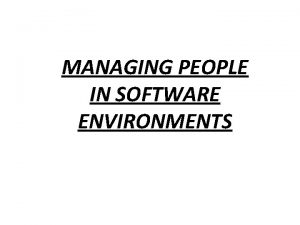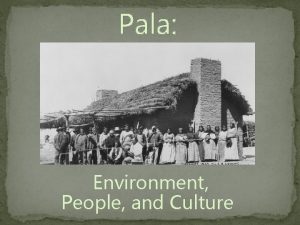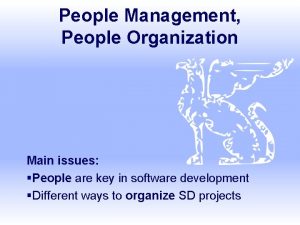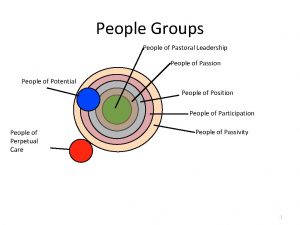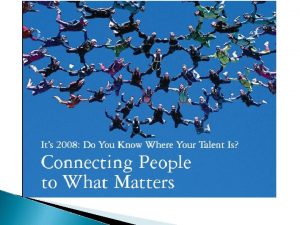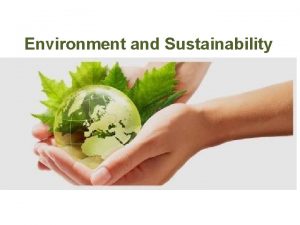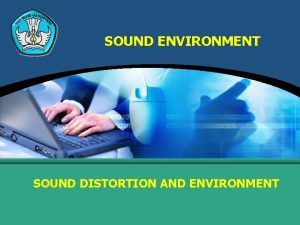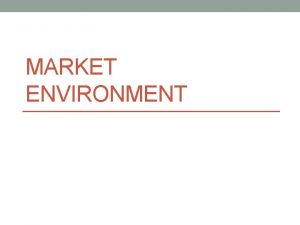Chapter 6 People and the Environment The environment

































- Slides: 33

Chapter 6: People and the Environment The environment is a source of economic opportunity, a repository of meaning, a sometime hazardous context, and always the background to our individual and collective lives. 5 themes of geography: Human – environment interaction • Adaptation • Alteration View of Cape Town, South Africa from Table Mountain. Expanded by Joe Naumann, UMSL

Chapter Learning Objectives • Identify the three basic forms of socio-spatial-economic relations and their spatial significance. • Describe ways that humans have managed the environment and how economic dynamics have impacted perceptions of the environment. • Discuss societies’ growing environmental awareness and the changing social construction of the environment. • Explain political ecology and relate it to the impacts of human activities on the global environment. • Outline some examples of major natural hazards and disasters by citing both their human and physical features.

To adapt or to alter, that is the question! • At low levels of technology, humans mostly have to adapt to the environment – In the high latitudes, they have to develop warm clothing (adapting to the environment), particularly for winter. In the low latitudes clothing is less necessary – If people traveling by canoe reach a point where nthey need to use a different nearby river, they have to portage (carry – adapting to the environment) the canoe to the other river. People with a higher level of technology may dig a canal to connect the rivers (altering the environment), saving time and effort to make that trip. • The higher the technology, the more the environment can be altered.

Most Life is based on carbon

5 Recycled & Recycling Solar-Powered World • Studying patterns and relationships, one discovers that the world is one gigantic system composed of intrerconnected and interdependent cycles and sub-systems. • Everything & everyone is connected and recycled!

6 Key Cycles • Rock Cycle ALSO

7

To alter or not to alter? • Important maxim: Just because we can do something, that doesn’t mean we should do it? Or, when in doubt, don’t! • Examine the 4 laws of ecology as they relate to the decision – Everything is connected (even if you don’t see it) – Everything goes somewhere – Nature knows best – There’s no such thing as a free lunch (there always consequences) • Before altering, STUDY DEEPLY – What are the connections? Where are things going? What are they doing? Are there more good consequences or bad consequences?

Environment and Cultural Meaning - Cultural factors: world view objectives, & level of technology • Three basic forms of socio-spatialeconomic relations • Environment’s affect • Conceptions of environmental space – Hunter-gatherers and sacred space – Cultural encounters between huntergatherers and other societies – Traditional agriculture and productive space – Urban-industrial systems and managed space The productive space of a rice paddy in Bali, Indonesia.

Social-Spatial-Economic Relations • Hunting-gathering societies and Sacred Space – Gendered and age division of labor – Close connection with environment as sacred space – Human-nature based on sustenance and spirituality • Cultural Encounters – Interaction of societies with different cosmologies and environmental views • Example: Canadian and Indigenous encounters – Mapping of lands an outcome of native knowledge – Symbiotically destructive relationship

Social-Spatial-Economic Relations • Shift from sacred to productive space – Annual cycle of festivals and rituals – Agriculturalists stress sacrifice and fertility • Commodified agriculture for profit – Land as commodity, to accumulate wealth The productive space of a rice paddy in Bali, Indonesia.

Managed Space • Managed space emerged with urban industrialization – Control over nature – Romanticism reaction to scientific rationalism – Ecology concern with links between living things • Environmental awareness – Environmental Kuznets Curve – Deep ecology to moderate sensitivity – New debates linking political issues, like ecofeminism Shows the link between economic growth and environmental quality.

Environmental Impacts on Society • Emotional “affect” of space to feel or act – Influence individuals – Encoded with specific behaviors – Bystander effect • Context of place – Complex social construction – Changes over time Avenue Habib Bourguiba in Tunis, Tunisia. Constructed during French occupation.

Human Impacts and Environmental Change • Geographers describing human impacts – The Earth as Transformed by Human Action (1990) • Major impacts 1. Habitat destruction and loss of biodiversity 2. Pollution of water and soil 3. Land use changes (desertification, deforestation, soil loss) 4. Global climate change The urbanization of the rural landscape, Maryland.

Human Impacts and Environmental Change • Consider social and political effects that drive change • Case of Colombia – Decline in forest cover and hunting-gathering – Periods of landscape change: conquest, colonization, state, and international markets Land use change in Colombia is linked to political and economic changes. See Table 6. 1.

Land Use Changes in Colombia 1500 -2000 Table 6. 1 Researchers identified seven periods of landscape change. From 1500 to 2000, there was a marked longterm decline in forest cover, a drastic reduction in nomadic hunting-gathering in savannas, and increase in grazing on cleared land natural grasslands.

Human Impacts and Environmental Change • Ground Truthing – Finer-grained processes to see effects and impacts on households, vulnerabilities, and coping strategies – Use of varying tools like traditional map comparison to more modern remote sensing – Use of different scales of analysis – Aware of locational bias in ecological studies • Political Ecology – Socioeconomic factors and environmental change – Struggle over resources: how control, costs, and benefits are apportioned among corporations and households

Human Impacts and Environmental Change • Global climate change – Many factors; most important is heavy use of fossil fuels – Range of global dynamics – Produces a variety of household and regional effects, like “double exposure” of accompanied political or economic changes Impacts Related to Climate Change • Climate change produces a variety of different effects. The official federal site that collates data on the United States has a regional breakdown. Much of the basic data and some striking images are available at the NASA website (http: //climate. nasa. gov/).


Human Impacts and Environmental Change • Landscape as text – Revealing power and deeper economic and political relations – Reflect dominant cultures, traces of alternative cultures • Landscape important in creation of place identities and historical memory Creating sugar cane plantations from tropical rainforest in Queensland, Australia

Human Impacts and Environmental Change • Hazards and Disasters – Hazards become disasters when vulnerability is high – High vulnerability: large, dense populations and high marginality • Disasters do not effect everyone equally – Hurricane forecasting and mitigation varies – Global warming will have different effects – Hurricane Katrina worse impact on most vulnerable Hurricanes in the Caribbean and Eastern United States.

The Tragedy of the Commons? • Garrett Hardin (1968) – When individuals use collective resources, each individual maximizes personal interest – Overuse results in decline of common space – Solution? Government regulation or privatization • Elinor Ostrom (1990) argues against simple solution – Principles of common-pool resource management

2 3 Sequent occupance reveals culture changes 1. Cultural landscape – the total impact of human action upon the natural conditions – changes made by humans – an expression of their culture. • Cultures rise and fall • Cultures change • Cultures are replaced by other cultures 2. The cultural landscape changes in response to the growth of a culture or its replacement

2 4 Central America Sequence

2 5

2 6

2 7

2 8

2 9

3 0

The Anthropocene • The End of Nature ? – New form of earth being created by humans – Associated with permanent changes • Anthropocene and world anthromes – Natural ecosystem loss, – Benefits are short-term and has long-term costs • Decline of biodiversity – Rewilding movement

Chapter Summary • Human-environment relations at the heart of human geography. Three basic forms of social-spatial-economic relations: hunting-gathering, traditional agriculture, and urbanindustrial systems. • For hunting-gathering societies, nature is functional and economic, and is filled with spiritual and cosmological meaning. • Shift to agriculture production also shifted from the notion of sacred space to view of spaces as being productive. • Competing claims on the importance of the environment. Powerful forces promoting continued economic growth and tend to see nature as a commodity. Also increasing powerful awareness of unrestrained growth’s environmental consequences. • The environmental Kuznets Curve suggests a relationship between growing environmental awareness and increasing income.

Chapter Summary • Variety of opinions on appropriate policy responses to promote environmental awareness, ranging from “deep ecology” to an environmental sensitivity emphasizing alternative technologies, pollution reduction, and sustainable development. • Research shows mood and behavior both affected by environment and surroundings play a role in people’s sense of well-being. • Most significant human impact is global climate change. • One line of research in human geography looks specifically at landscape as an embodiment of the people/nature relationship. • Of the most visible and dramatic examples of people-nature relations is the experience of hazards and disasters. These experiences tell about the human geography of class and power. • We live in the Anthropocene, a world of our own making.
 People as media vs people in media
People as media vs people in media Black eyed peas where is the love lyrics
Black eyed peas where is the love lyrics Financial environment in business environment
Financial environment in business environment Managing people in software environment
Managing people in software environment Recovery community
Recovery community People just people
People just people Hát kết hợp bộ gõ cơ thể
Hát kết hợp bộ gõ cơ thể Bổ thể
Bổ thể Tỉ lệ cơ thể trẻ em
Tỉ lệ cơ thể trẻ em Voi kéo gỗ như thế nào
Voi kéo gỗ như thế nào Glasgow thang điểm
Glasgow thang điểm Alleluia hat len nguoi oi
Alleluia hat len nguoi oi Các môn thể thao bắt đầu bằng tiếng bóng
Các môn thể thao bắt đầu bằng tiếng bóng Thế nào là hệ số cao nhất
Thế nào là hệ số cao nhất Các châu lục và đại dương trên thế giới
Các châu lục và đại dương trên thế giới Công thức tính độ biến thiên đông lượng
Công thức tính độ biến thiên đông lượng Trời xanh đây là của chúng ta thể thơ
Trời xanh đây là của chúng ta thể thơ Mật thư anh em như thể tay chân
Mật thư anh em như thể tay chân Phép trừ bù
Phép trừ bù độ dài liên kết
độ dài liên kết Các châu lục và đại dương trên thế giới
Các châu lục và đại dương trên thế giới Thơ thất ngôn tứ tuyệt đường luật
Thơ thất ngôn tứ tuyệt đường luật Quá trình desamine hóa có thể tạo ra
Quá trình desamine hóa có thể tạo ra Một số thể thơ truyền thống
Một số thể thơ truyền thống Cái miệng nó xinh thế
Cái miệng nó xinh thế Vẽ hình chiếu vuông góc của vật thể sau
Vẽ hình chiếu vuông góc của vật thể sau Thế nào là sự mỏi cơ
Thế nào là sự mỏi cơ đặc điểm cơ thể của người tối cổ
đặc điểm cơ thể của người tối cổ Thế nào là giọng cùng tên
Thế nào là giọng cùng tên Vẽ hình chiếu đứng bằng cạnh của vật thể
Vẽ hình chiếu đứng bằng cạnh của vật thể Vẽ hình chiếu vuông góc của vật thể sau
Vẽ hình chiếu vuông góc của vật thể sau Thẻ vin
Thẻ vin đại từ thay thế
đại từ thay thế



